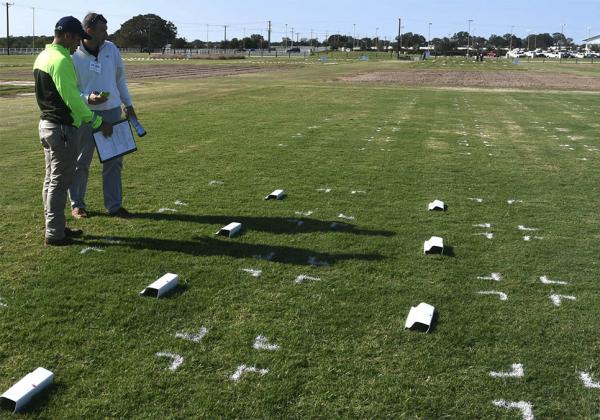Cold-brewed java isn't just the latest hipster trend for millennials at the local coffee house. It also might provide a morning pick-me-up for golf course turf, say researchers at Texas A&M.
 A two-year study under way at the TAMU AgriLife Research and Extension Center focuses on spreading used coffee grounds on turf to see whether the nitrogen they contain can help boost grass the same way they provide that much-needed morning charge.
A two-year study under way at the TAMU AgriLife Research and Extension Center focuses on spreading used coffee grounds on turf to see whether the nitrogen they contain can help boost grass the same way they provide that much-needed morning charge.The focus of the study is to determine whether used coffee grounds can replace some of the fertilizers and soil amendments commonly used to produce healthy turf, says Ben Wherley, Ph.D., associate professor in crop and soil sciences at TAMU.
He and Garrett Flores, a master's student at the school in College Station, will compare fresh and composted grounds to other organic and synthetic fertilizers and sphagnum peat moss.
The work is funded partly through a grant from the U.S.G.A. Green Section and GeoJava, a spinoff of Aspen Beverage, which offers industrial beverage solutions in the San Antonio area.
The grounds, which are supplied by Aspen, will be used in the study both as a substitute for fertilizers and soil amendments, Wherley said.
"We think this might provide a nice alternative by using a spent resource and not cutting into a non-renewable resource like peat moss," Wherley said in a release through TAMU.
Flores and Wherley are operating under the hypothesis that the nutritional value in coffee grounds will compare favorably to both slow- and quick-release fertilizers, poultry-based organic fertilizers, ammonium sulfate and sulfur-coated urea. They also will be evaluating changes in the soil microbial biomass due to spent coffee grounds as well as other fertilizer treatments.
There was a day when such research would not have been feasible because of a lack of grounds available for widespread commercial applications. That's no longer true today. Aspen produces about 40 cubic yards of coffee grounds daily, and is supplying those used in the TAMU study. That's enough to fill a dumpster 22 feet by 7.5 feet by 8 feet, and production is expected to increase by 500 percent by next year.
If the grounds can be repurposed for turf nutritional needs, it will allow Aspen and the countless other companies like it nationwide to dispose of the grounds in an environmentally and economically beneficial way.
The spike in coffee consumption is attributed to the rising popularity of cold-brewed coffee, which is said to be less acidic than traditional brewed coffee, so people who never drank coffee before now are cold-brewed coffee consumers, and the plentiful supply of grounds makes such research not only feasible but quite relevant.
A total of 10 treatments are underway at TAMU, including an untreated control. Coffee grounds tested are both fresh and composted. The composted coffee grounds analysis indicates they have a slightly higher nutrient level, the researchers say.
The spent coffee grounds have about a 2.5-3 percent nitrogen content, and a carbon to nitrogen ratio of about 20 to 1, nutritional benefits that could make them desirable to turf managers.
Cold brew packs twice as much punch
Cold brewing is a slow process that substitutes time for temperature in the extraction process. When cold water is used to brew the coffee, some of the compounds that come out at higher temperatures are left in the bean. These are the fatty acids and oils that can cause bitterness.
The result of cold brewing is a coffee with less than half the acid of hot brewing, making cold brew very smooth. This smoothness makes it possible, even desirable to drink cold-brew coffee at about twice the strength of regular hot-brewed coffee, which means twice as much coffee and twice the caffeine per ounce, Wherley said.
Regardless of which coffee grounds are used, they spread easily out of a rotary spreader if dried.
GeoJava has been working with local landscapers in San Antonio that have been doing top dressing applications for many years.

